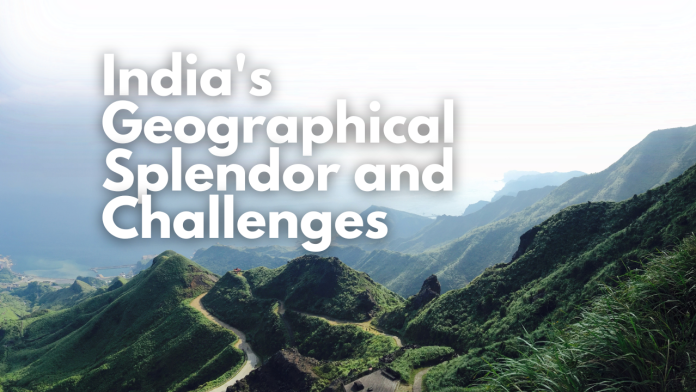India, a nation of unparalleled diversity and beauty, is defined by its geographical splendor and unique challenges. From the snow-capped peaks of the Himalayas to the sun-drenched shores of its southern coasts, the geography of India is a testament to nature’s artistry. But this diversity also presents a set of challenges that India must grapple with.
The Himalayan Majesty: India’s Northern Frontier
In the northern frontier of India, the Himalayan mountain range stands tall and majestic, earning the moniker “Abode of Snow.” These towering peaks, including the world’s highest, Mount Everest, are a source of pride for the nation. They not only serve as a natural border but also hold a spiritual significance, often referred to as the dwelling place of the gods.
But along with the awe-inspiring beauty, these mountains pose significant challenges to India. The region is prone to earthquakes, landslides, and flash floods, making it vital to have robust disaster management strategies.
The Thar Desert’s Harsh Beauty
To the northwest, the Thar Desert stretches across Rajasthan, offering a stark contrast to the lush landscapes of other regions. The arid beauty of the desert with its golden sands and camel caravans is truly captivating. However, living in such an environment is no easy feat. The harsh desert climate presents a daily challenge to the people who call it home. Water scarcity and extreme temperatures are ongoing battles.
Gangetic Plains: The Breadbasket and Beyond
The Gangetic Plains, extending from the Himalayan foothills to the Deccan Plateau, are India’s agricultural heartland. The fertile soil nourished by the Ganges and Yamuna rivers supports bountiful harvests and sustains millions of livelihoods. This region is also home to rich cultural heritage and historical sites, such as the ancient city of Varanasi.Nonetheless, overpopulation and environmental issues like pollution and over-exploitation of resources pose serious challenges to the Gangetic Plains. Finding a balance between development and preservation is an ongoing struggle.
Western Coast’s Serene Charms
India’s western coast along the Arabian Sea is known for its serene beaches, coconut groves, and vibrant coastal culture. States like Goa and Kerala draw tourists from around the world with their natural beauty and warm hospitality. The coastline’s positive impact on tourism and economy is evident.However, the delicate coastal ecosystems are at risk due to unchecked development and pollution, threatening the very beauty that draws people to these shores.
The Eastern Tapestry
The eastern part of India is a tapestry of lush forests and intricate river deltas. The Sundarbans in West Bengal, with its mangrove forests, is home to the magnificent Royal Bengal Tiger. Assam’s tea gardens contribute to India’s global tea production.Yet, the region faces challenges such as deforestation, habitat loss, and the need for sustainable practices to preserve these unique landscapes.
Island Paradise – Andaman and Nicobar Islands
Off the southeastern coast, the Andaman and Nicobar Islands offer a paradisiacal retreat with white sandy beaches and vibrant coral reefs. The islands are a haven for biodiversity and nature enthusiasts.Challenges here include preserving the fragile ecosystems, addressing potential overcrowding, and maintaining a balance between development and conservation.
Conclusion
India’s geographical splendor is undeniable, with each region having its unique charm and significance. However, these blessings come with challenges that demand attention and action. India must continue to celebrate its beauty while addressing the environmental and social challenges that arise from its geographical diversity.In this country of contrasts, the story of India’s geography is one of resilience, adaptation, and an enduring love for the land. It’s a reminder that the balance between splendor and challenge is what makes India truly remarkable.
FAQs
- What are the primary challenges associated with the Himalayan region?
- The Himalayan region is prone to natural disasters like earthquakes and landslides. These challenges necessitate robust disaster management strategies and infrastructure development.
- How do people in the Thar Desert cope with the harsh environment?
- The people of the Thar Desert have adapted to the challenging conditions through practices such as water conservation, reliance on hardy desert flora and fauna, and the use of traditional desert architecture.
- What are some of the environmental concerns in the Gangetic Plains?
- The Gangetic Plains face issues like pollution, overpopulation, and over-exploitation of resources. Environmental conservation and sustainable development are essential to address these concerns.
- How can India protect its fragile coastal ecosystems on the western coast?
- Protecting the western coast’s delicate ecosystems requires responsible development practices, pollution control, and measures to mitigate the impacts of climate change.
- What measures are being taken to conserve the biodiversity in the Andaman and Nicobar Islands?
- Conservation efforts in the Andaman and Nicobar Islands include the establishment of protected areas, the promotion of sustainable tourism, and the enforcement of strict regulations to preserve the unique ecosystems.



